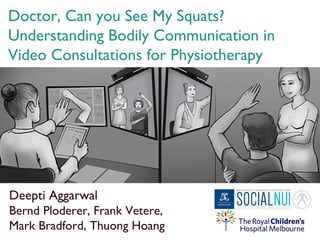Doctor, Can You See My Squats?: Understanding Bodily Communication in Video Consultations for Physiotherapy.
- 1. Doctor, Can you See My Squats? Understanding Bodily Communication in Video Consultations for Physiotherapy Deepti Aggarwal Bernd Ploderer, Frank Vetere, Mark Bradford, Thuong Hoang
- 2. 2 Increasing demands for healthcare
- 4. Bodily Communication in Clinical Consultations
- 5. EXAMINE FEEL COMFORT DIAGNOSE Different use of Bodily Communication
- 6. Bodily Communication in Physiotherapy
- 9. 2 physiotherapists & 5 patients with chronic pain Prescribed exercises: tip-toes, squats FACE TO FACE (3) VIDEO (7)
- 10. FACE-TO-FACE VIDEO 1. OPENING 2. COMPLAINT 3. EXAMINATION 4. DIAGNOSIS 5. TREATMENT 6. CLOSING
- 11. FACE-TO-FACE VIDEO Appearance (Full body) Posture Movement (walking) Orientation Appearance (Upper torso) Posture Movement (walking) Orientation #1. OPENING
- 12. VIDEO Quality of movements (depth, range, & smoothness) #2. HISTORY TAKING Quality of movements (depth and range, smoothness) FACE-TO-FACE Facial expressions (tears, red cheeks, tensed eyes) Facial expressions (tears, red cheeks, tensed eyes) Eye contact (for encouragement, willingness to engage) Eye contact (for encouragement, willingness to engage)
- 13. VIDEO Tactile feedback (body tightness, inflammation, body temperature) Response to touch (fear, protective spasm, facial expression) #3, 4. EXAMINATION & DIAGNOSIS Tactile feedback (body tightness, inflammation, body temperature) Response to touch (fear, protective spasm, facial expression) Touch on patientˇŻs body Touch on own body FACE-TO-FACE
- 14. VIDEO Full body posture Efforts (fatigue, tremor) Facial expressions Tone of speech (pitch) Touch on patientˇŻs body Full body posture Efforts (fatigue, trmeor) Facial expressions Tone of speech (pitch) Touch on own body #5. TREATMENTFACE-TO-FACE
- 15. VIDEO Body language Facial expressions Facial expressions Body language #6. CLOSINGFACE-TO-FACE
- 16. Video limits a wide range of bodily cues Best suitable for follow up consultations Key Takeaways
- 17. 17 Increasing demands for healthcare
- 19. Visual Acuity
- 20. Field-of-view
- 22. 22 Key references behaviour of general practitioners consulting in their surgeries. Her Majesty's Stationery Office, London, England. Christian Heath.1986. Body movement and speech in medical interaction. Cambridge University Press. Christian Heath. 2002. Demonstrative Suffering: The Gestural (Re)embodiment of Symptoms.Journal of Communication, 52(3), 597-616. Helena M. Mentis, Rita Shewbridge, Sharon Powell, Melissa Armstrong, Paul Fishman, and Lisa Shulman, 2015. Co-Interpreting Movement With Sensors: Assessing ParkinsonˇŻs PatientsˇŻ Deep Brain Stimulation Programming. Human Computer Interaction 2015, 1-34. Edward Alan Miller. 2011. The continuing need to investigate the nature and content of Teleconsultation communication using interaction analysis techniques. Telemedicine and Telecare, 17(2): 55-64.






















